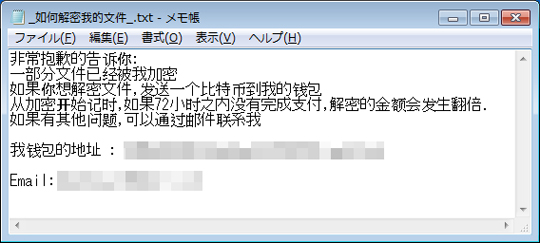Ransom.Win32.BITPAYMER.TGACAK
Windows


Threat Type: Ransomware
Destructiveness: No
Encrypted:
In the wild: Yes
OVERVIEW
Downloaded from the Internet, Dropped by other malware
This Ransomware arrives on a system as a file dropped by other malware or as a file downloaded unknowingly by users when visiting malicious sites.
It connects to certain websites to send and receive information.
It drops files as ransom note.
TECHNICAL DETAILS
708,096 bytes
EXE
Yes
09 May 2019
Connects to URLs/IPs, Drops files, Encrypts files, Displays message/message boxes, Terminates processes
Arrival Details
This Ransomware arrives on a system as a file dropped by other malware or as a file downloaded unknowingly by users when visiting malicious sites.
Installation
This Ransomware adds the following mutexes to ensure that only one of its copies runs at any one time:
- SATAN_CRYPT
Process Termination
This Ransomware terminates the following services if found on the affected system:
- MySQLa
- SQLWriter
- SQLSERVERAGENT
- MSSQLFDLauncher
- MSSQLSERVER
- UxSms
It terminates the following processes if found running in the affected system's memory:
- calc.exe
- sqlservr.exe
- mysqld.exe
- nmesrvc.exe
- sqlagent.exe
- fdhost.exe
- fdlauncher.exe
- reportingservicesservice.exe
- omtsreco.exe
- tnslsnr.exe
- oracle.exe
- emagent.exe
- perl.exe
- sqlwriter.exe
- mysqld-nt.exe
Dropping Routine
This Ransomware drops the following files:
- %Windows%\Temp\Ssession - contains a {random string}
(Note: %Windows% is the Windows folder, where it usually is C:\Windows on all Windows operating system versions.)
Other Details
This Ransomware connects to the following website to send and receive information:
- http://{BLOCKED}.159.106/cyt.php?code={random string}&file=0&size=0&sys=win&VERSION={windows version}&status={start | db | done}
Ransomware Routine
This Ransomware avoids encrypting files with the following strings in their file name:
- .conn
- .crypt
- .data
- .hash
- .loop
- .ltmp
- blue.fb
- blue.xml
- boot.ini
- desktop.ini
- star.fb
- star.xml
- satan_pro
- cab
- pol
- dll
- msi
- exe
- lib
- iso
- bin
- bmp
- tmp
- log
- ocx
- chm
- dat
- sys
- wim
- sdi
- lnk
- gho
- pbk
It avoids encrypting files with the following strings in their file path:
- 360downloads
- 360rec
- 360safe
- 360sand
- 360sec
- all users
- boot
- common files
- default user
- dvd maker
- favorites
- i386
- intel
- internet explorer
- jdk
- libs
- microsoft
- microsoft games
- msbuild
- public
- python2
- python3
- recycle
- temp
- uname
- upass
- windows
- windows defen
- windows mail
- windows media pl
- windows nt
- windows photo viewer
- windows sidebar
It renames encrypted files using the following names:
- [satan_pro@mail.ru]{original filename}.{random string}.satan_pro
It drops the following file(s) as ransom note:
- {drive letter}:\_如何解密我的文件_.txt
It leaves text files that serve as ransom notes containing the following text:
SOLUTION
9.850
14.954.04
22 Apr 2019
14.955.00
23 Apr 2019
Step 1
Before doing any scans, Windows 7, Windows 8, Windows 8.1, and Windows 10 users must disable System Restore to allow full scanning of their computers.
Step 2
Note that not all files, folders, and registry keys and entries are installed on your computer during this malware's/spyware's/grayware's execution. This may be due to incomplete installation or other operating system conditions. If you do not find the same files/folders/registry information, please proceed to the next step.
Step 3
Identify and terminate files detected as Ransom.Win32.BITPAYMER.TGACAK
- Windows Task Manager may not display all running processes. In this case, please use a third-party process viewer, preferably Process Explorer, to terminate the malware/grayware/spyware file. You may download the said tool here.
- If the detected file is displayed in either Windows Task Manager or Process Explorer but you cannot delete it, restart your computer in safe mode. To do this, refer to this link for the complete steps.
- If the detected file is not displayed in either Windows Task Manager or Process Explorer, continue doing the next steps.
Step 4
Search and delete these files
- {drive letter}:\_如何解密我的文件_.txt
- %Windows%\Temp\Ssession
Step 5
Scan your computer with your Trend Micro product to delete files detected as Ransom.Win32.BITPAYMER.TGACAK. If the detected files have already been cleaned, deleted, or quarantined by your Trend Micro product, no further step is required. You may opt to simply delete the quarantined files. Please check the following Trend Micro Support pages for more information:
Step 6
Restore encrypted files from backup.
Did this description help? Tell us how we did.


